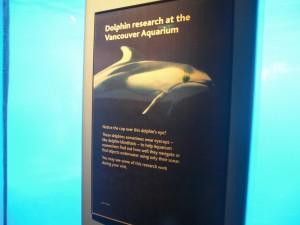The biggest thing I realized when researching this topic was that there are two divided camps on either side of this issue. One side is opposed to having dolphins in captivity. This side argues that it is unethical to keep dolphins in captivity based primarily on the intelligence levels of these animals, saying that dolphins are too smart for captivity. The other side of the issue argues that dolphins are well treated in captivity, free from predation pressure, boat traffic, and the challenge of finding food. This side argues that the benefits for both humans and dolphins far exceed any issues of welfare or boredom that individual dolphins may experience.
Opposed to Dolphin Captivity
The groups on this side of the fence are primarily animal activist groups, animal welfare organizations, and some scientists such as Lori Marino, a vocal proponent of abolishing dolphin captivity. The views of these groups can range from moderate to extreme, but the general consensus is that dolphins should not be kept in captivity. Organizations such as the Whale and Dolphin Conservation Society are fighting to end captivity of dolphins and “Keep Whales Wild.” The Humane Society of the United States, along with WSPA, the World Society for the Protection of Animals, published a lengthy report in 2009 entitled “The Case Against Marine Mammals in Captivity” This report goes into detail all of the issues involved worldwide around captive marine mammals, from hunting methods that do extensive harm, to statistics about aquarium and zoo facility cetacean survival rates, to breeding programs, to the use of marine mammals in research. Following the Great Ape Project that was intended to grant personhood rights to the great apes (chimps, bonobos, gorillas, and orangutans), there has been push recently to grant non-human person rights to cetaceans as well. The Declaration of Rights for Cetaceans was presented by Lori Marino and other scientists at the American Association for the Advancement of Science annual meeting. Such a declaration actually becoming law in any country would require a lot of agreement. Personhood for cetaceans would have widespread implications, involving the removal of dolphins from zoos and aquariums on the basis of imprisonment. This of course is the ultimate goal of this side of the issue. Lori Marino and the other proponents of this case argue that while we have learned much from dolphin research, the time for research on captive dolphins is past and that any future research should only be done on wild dolphins (Towards a New Paradigm of Non-Captive Research). She advocates the use of dolphins that ‘choose’ to come in contact with humans and non-disruptive observational techniques.
Proponents for Dolphin Captivity
The most obvious supporters of dolphin captivity are the zoos and aquariums that keep the animals, which when it comes down to it is about economics. Dolphins are a major draw for the public, and people will spend a lot of money to see and/or interact with these animals. There are other supporters for dolphin captivity, including CAZA, AZA, and a large number of scientists involved in dolphin research. In response to “The Case Against Marine Mammals In Captivity” published by the Humane Society of the United States, Stan Kuczaj, the editor of the “International Journal of Comparative Psychology“, published two entire issues bringing together experts on marine mammal research to argue the case for keeping marine mammals in captivity. These issues (available here and here) outline the extensive research that goes on using captive dolphins, and maintain that the only way this information can be gathered is through the use of captive animals. Research requires as much control over a situation as possible, to try to gain insight into a topic without too many confounding variables. Captive situations allow for control of the environment, food intake, number of samples, and many other conditions that can’t be achieved in the wild. Captivity allows for long term behavioural studies, as well as a continuing progression of veterinary information with every illness and treatment in captive settings. There is some cetacean research going on at the Vancouver Aquarium, with the dolphins having been trained to wear gel eyecups so that their sonar and ecolocation abilities can be studied. There are also metabolic studies going on at the aquarium, with the dolphins having been trained to enter a metabolic tent that floats on the water, so that their oxygen consumption can be measured to help scientists figure out how much energy it takes to be a dolphin. Both of these research projects have applications for wild dolphin populations. With better understanding of dolphin sonar, researchers are hoping to learn more about why dolphins get caught in fishing nets, and if there are ways to make nets more visible to dolphins. Metabolic studies give an indication of how much energy a dolphin needs to survive, and by extension, how much food it needs to consume. This is important for dolphin conservation when looking at maintaining fish populations so that the dolphins have enough to eat.

Video from Global news about ecolocation research being done at the Vancouver Aquarium